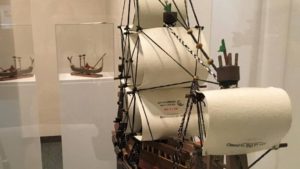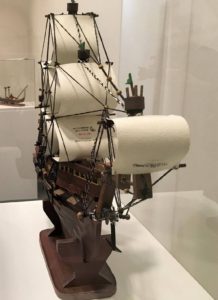The prison at Guantánamo Bay, Cuba, put its stamp of approval for release on the sail of this model ship built by Yemeni captive Moath al Alwi from paper and other found objects at the Camp 6 communal prison for low value detainees. It was on display on Oct. 25, 2017 at the John Jay College of Criminal Justice as part of an exhibit of art made at the prison by captives past and present. CAROL ROSENBERG [email protected]
BY CAROL ROSENBERG
[email protected]
November 16, 2017 06:07 PM
Updated November 20, 2017 12:21 PM
GUANTANAMO BAY NAVY BASE, CUBA
The military has decided that art made by wartime captives is U.S. government property and has stopped releases of security-screened prisoner art to the public. One attorney says the U.S. military intends to burn cellblock art.
The new source of tension in the 41-captive prison is stirring a fundamental question: Who owns art? The state or the artist?
U.S. military officials declined to explain what caused them to abandon the years-long practice of releasing detainee art after inspection by prison workers schooled in studying material for secret messages under the rubric of Operational Security.
But an ongoing exhibit at New York’s John Jay College of Criminal Justice featuring paintings and other works by current and former captives — which garnered international press coverage — apparently caught the attention of the Department of Defense. Online, the exhibition called “Ode to the Sea,” offered an email address for people “interested in purchasing art from these artists.”
A Pentagon spokesman, Air Force Maj. Ben Sakrisson, said Wednesday that all Guantánamo detainee art is “property of the U.S. government” and “questions remain on where the money for the sales was going.”
The prison at Guantánamo Bay, Cuba, put its stamp of approval for release on the sail of this model ship built by Yemeni captive Moath al Alwi from paper and other found objects at the Camp 6 communal prison for low value detainees. It was on display on Oct. 25, 2017 at the John Jay College of Criminal Justice as part of an exhibit of art made at the prison by captives past and present.
At the prison, Navy Cmdr. Anne Leanos said in a statement that “transfers of detainee made artwork have been suspended pending a policy review.”
Lawyers for the captives discovered the change in recent visits when troops at the 1,500-staff prison inexplicably stopped returning art that had been submitted for inspection and release. Then, according to two attorneys who represent several of the last 41 war-on-terror detainees, a commander told general population captives that they would no longer be allowed to give it away.
Attorney Ramzi Kassem said one captive was told “art would not be allowed out of the prison.” Now, if a captive gets to leave Guantánamo “their art would not even be allowed out with them and would be incinerated instead.”
Attorney Beth Jacob said a different client told her by telephone from the prison that “the colonel” announced that “they could continue to make art. But the number of pieces each could have would be limited, and excess ones would be discarded.”
Not only were the captives no longer to give their lawyers works of art as gifts, but the prison would no longer let the International Red Cross receive artwork for their families, the detainee told Jacob. According to that account, the colonel told captives the change was at the direction of someone not at Guantánamo. An ICRC spokesman had no comment, and invoked the confidential nature of the humanitarian organization’s contacts with the U.S. administration.
In contrast, Federal Bureau of Prisons policy lets its inmates mail “arts and hobbycraft” to family, give them to certain visitors and sometimes display it in public space, if it meets the warden’s standard of taste.
Link: http://www.miamiherald.com/news/nation-world/world/americas/guantanamo/article185088673.html


